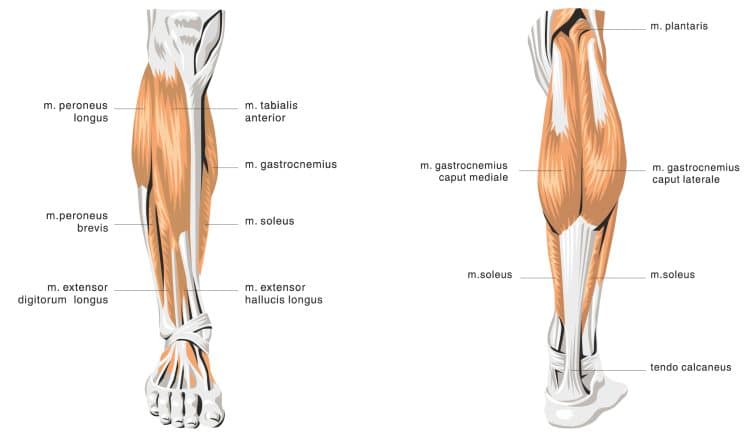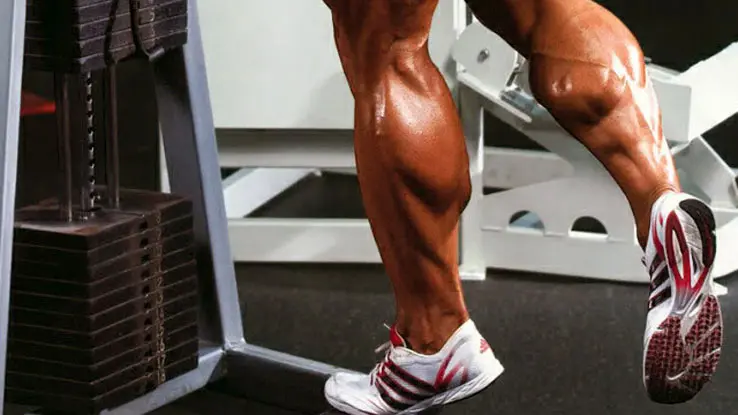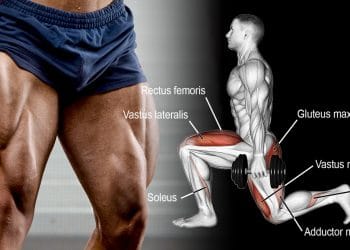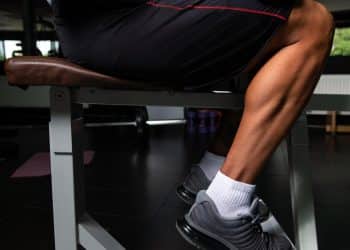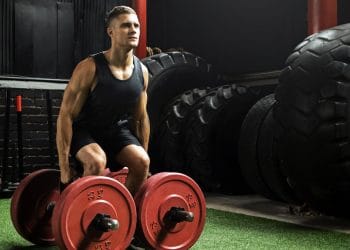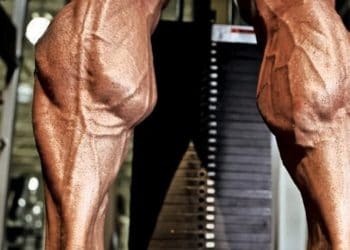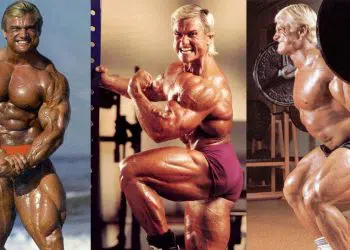Are you confused about the differences between seated and standing calf raises? Are you unsure which one you should do? We’re here to help!
Calf training is a controversial topic in bodybuilding. On the one hand, some people think calf size and shape are entirely genetic, and your choice of exercise or training methods doesn’t really matter. Your calves will always be the size and shape they are – unless you resort to implants or synthol injections, that is.
In contrast, other people say that the calves are highly trainable, and by doing calf exercises with your toes turned in, turned out, and parallel, you won’t just build bigger calves but can change their shape.
Needless to say, there is anecdotal evidence to support both perspectives, as some lifters find building bigger calves easy, while others are calf-hard-gainers. Regardless of your personal viewpoint, there is no denying that big calves look great and can add an extra dimension to your physique.
The most critical calf training decision that most people have to make is choosing between seated and standing calf raises. While there is nothing wrong with doing both, there may be times when you can only do one.
Now that we’ve set the stage, which should you choose?
Level Up Your Fitness: Join our 💪 strong community in Fitness Volt Newsletter. Get daily inspiration, expert-backed workouts, nutrition tips, the latest in strength sports, and the support you need to reach your goals. Subscribe for free!
In this guide, we delve into the differences between these calf exercises so you can finally decide which one to do.
Seated Calf Raise: The Basics
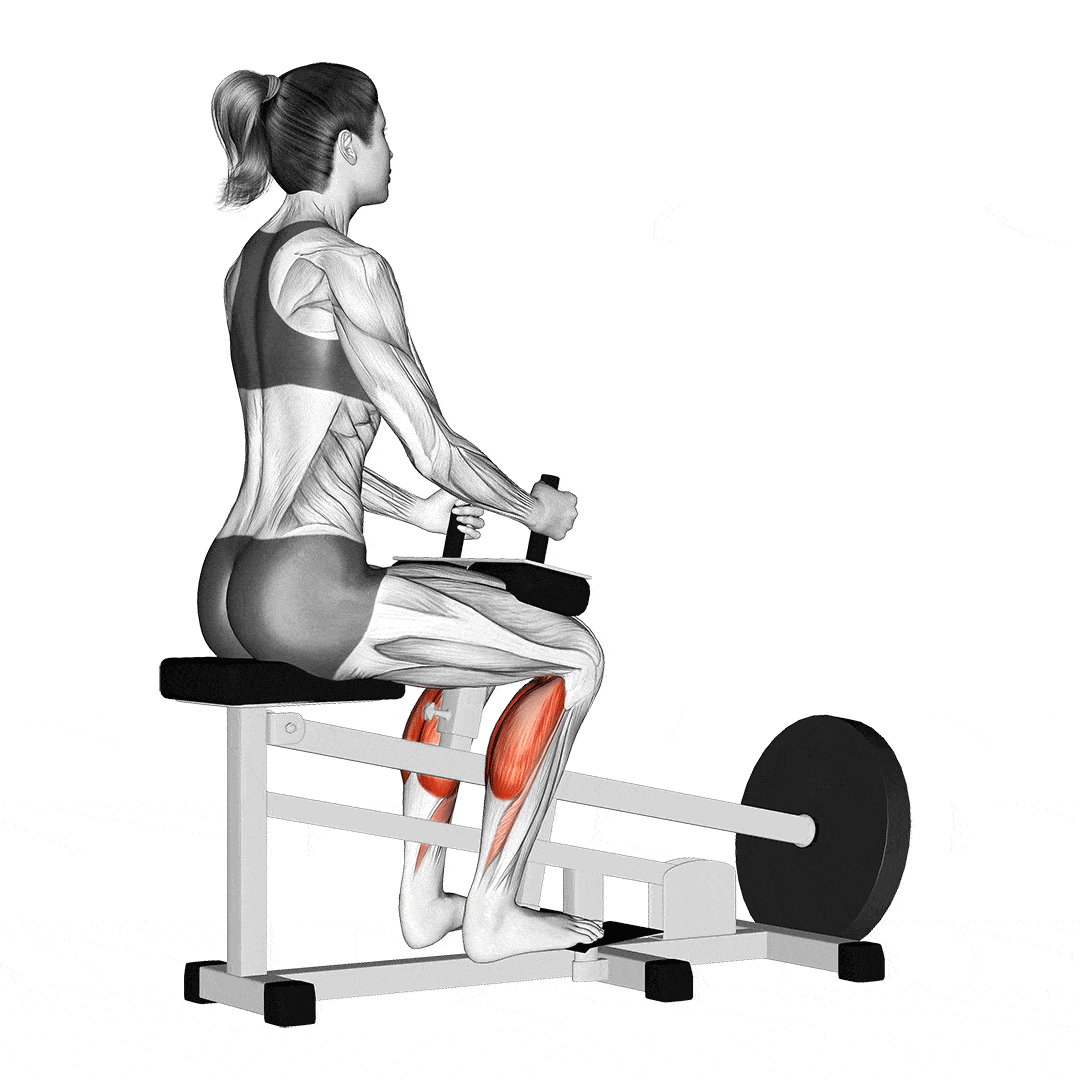
The seated calf raise is often overshadowed by the standing variation. That may be because seated calf raise machines are smaller and usually tucked away in the corner of the gym, out of sight and out of mind.
Regardless of why, the seated calf raise machine is generally less popular than standing calf raises.
Despite its apparent lack of popularity, the seated calf raise is an effective way to work your lower legs. The seated position is comfortable, and there are no compressive forces on your spine. In addition, you should be able to see your calves working as you crank out your reps, which can be very motivating.
That said, the seated calf raise is possibly not the most effective and efficient way to train your calves. This is because of how the calves function in relation to the angle of your knees, but more on that later.
For now, let’s take a look at which muscles are involved in seated calf raises.
Muscles Worked
It should be no surprise to learn that seated calf raises work your calves! But did you know that your calves actually comprise several individual muscles? These are:
Soleus
The soleus is the agonist or prime mover during seated calf raises. In other words, it’s the muscle doing most of the work. The soleus is a flat, long muscle that lies beneath and below your other main calf muscle – the gastrocnemius. The soleus is a uniaxial muscle, meaning it crosses just one joint – your ankle. Its primary function is plantarflexion (pointing) of the ankle.
Gastrocnemius
The gastrocnemius is the most superficial (outermost) and biggest of the calf muscles. It is biaxial and crosses two joints: the ankle and the knee. As such, it affects both these joints. Comprising two distinct heads – medial and lateral – the gastrocnemius’ primary function is plantarflexion of the ankle, and it also has a minor role in knee flexion.
Because it crosses the back of your knee, the gastrocnemius is in a somewhat slackened position during seated calf raises. Subsequently, it cannot generate maximal force during this exercise. So, while it’s still working, gastrocnemius activation is somewhat reduced during seated calf raises.
Plantaris
The plantaris is a slender muscle that helps to plantarflex the ankle. It also helps to flex the knee joint. However, the plantaris is not a very strong muscle, and its role in knee flexion is minimal.
Like the gastrocnemius, the plantaris is somewhat slack during seated calf raises and does not contribute much force to plantar flexion. The plantaris is relatively small and overshadowed by its larger, more powerful relatives – the soleus and gastrocnemius. As such, it doesn’t contribute much to calf size.
Together, these three muscles are often known as the triceps surae. However, where the soleus and gastrocnemius both attach to the calcaneus or heel bone via the Achilles tendon, the plantaris has its own tendon. Their collective name refers to their shared function of plantarflexing the ankle.
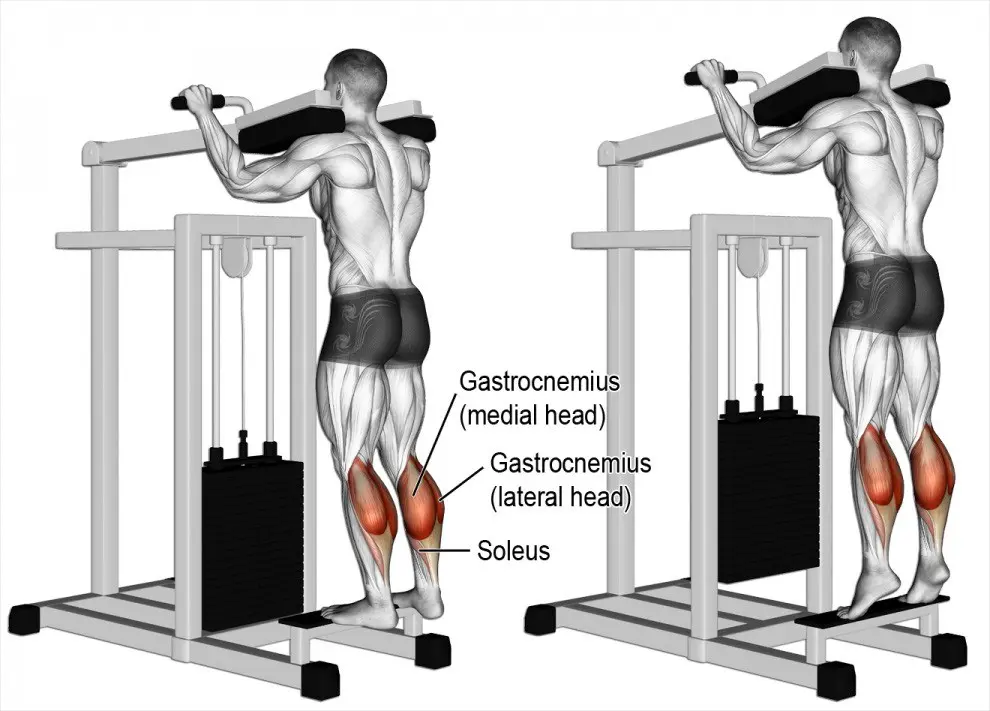
Now you know what muscles are trained during seated calf raises, let’s move on to how to do this soleus-dominant exercise.
How to Do Seated Calf Raises
Get the most from seated calf raises by doing them the right way!
- Start by selecting a weight you can lift for 10-12 reps with good form.
- Sit down on the calf raise machine and adjust the leg pad so that it sits across your thighs, just above the knees. Make sure it’s snug but not too tight.
- Place the balls of your feet on the footplate, with your heels hanging off the edge. Your feet should be hip-width apart and parallel to each other.
- Hold onto the handles or the sides of the seat for stability. Make sure your back is straight, and your core is engaged.
- Slowly lower your heels towards the ground, going as far down as comfortably possible to get a good stretch in the calf muscles. This is your starting position.
- Push through the balls of your feet to raise your heels as high as possible. At the top of the movement, pause for a moment and squeeze your calf muscles for maximum contraction.
- Slowly lower your heels back to the starting position, feeling a stretch in the calf muscles as you go down.
- Continue for the desired number of reps.
Pro Tips
- Avoid leaning back, as doing so takes work away from your calves.
- Use as large a range of motion as possible; half reps get half results!
- Position the thigh pad so it’s just above your knees for comfort.
- Make sure your shins are vertical before starting your set.
- Pump up the intensity of your workout with drop sets and set those calves on fire!
Now you know how to do seated calf raises correctly, let’s explore the advantages and disadvantages of this lower leg exercise.
Seated Calf Raise – Pros
Are seated calf raises the right exercise for your lower leg workouts? Consider these benefits and then decide!
Targets the Soleus Muscle
While all three calf muscles are involved in seated calf raises, it’s the soleus that’s doing most of the work (1). With the gastrocnemius and plantaris in a somewhat slackened state, the soleus has more work to do. As a consequence, the soleus is the prime mover/agonist during this exercise.
Very Spine-Friendly
The calves are strong muscles, and, as such, training them often involves heavy loads. With seated calf raises, none of this weight is supported by your spine, so there is no spinal or intervertebral disk compression to worry about. As such, seated calf raises are very back-friendly and suitable for exercisers with lower back pain.
Easy to Use
Most seated calf raise machines are very straightforward to use. Because of this, they’re suitable for beginners and exercisers looking for a simple way to train their calves. Most seated calf machines require very few adjustments, which will be less intimidating for beginners.
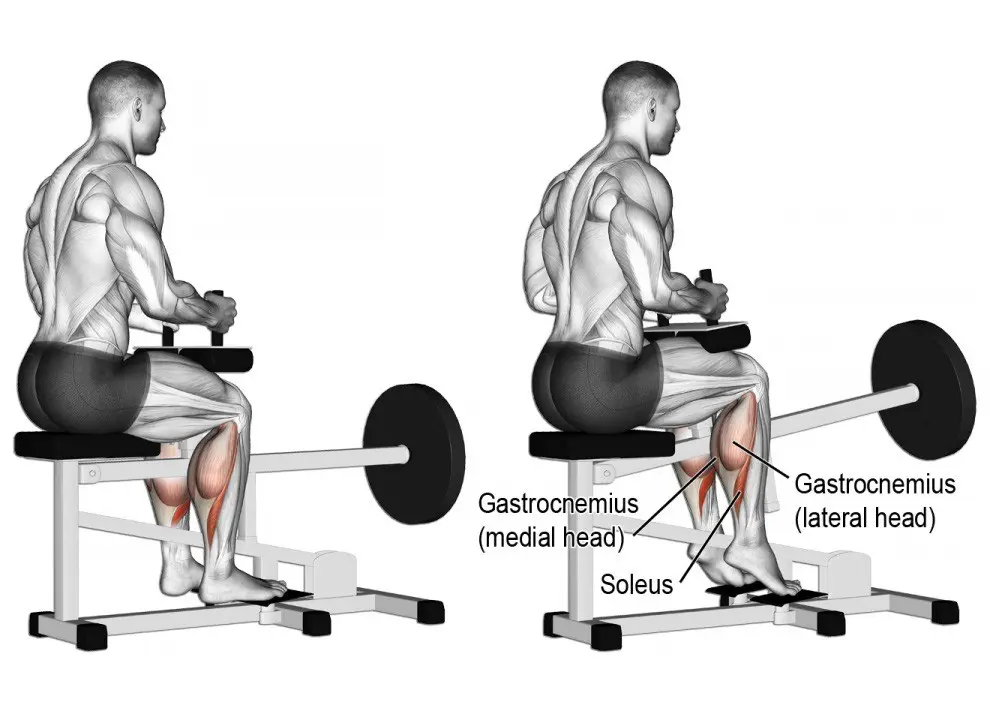
Seated Calf Raise – Cons
While seated calf raises can be effective, there are some disadvantages to consider before you add this exercise to your calf workouts:
Limited Range of Motion
Seated calf raises may not allow for as extensive a range of motion as standing variations, potentially limiting muscle engagement. Taking muscles through a large range of motion, and especially loading them in a stretched position, is thought to contribute to muscle growth.
Reduced Gastrocnemius Activation
While they target the soleus effectively, seated calf raises may not engage the gastrocnemius muscle as much as the standing version (1). This drawback could limit your calf gains, as the gastrocnemius is the most significant calf muscle with the greatest growth potential.
Dependency on Machines
Performing seated calf raises typically requires access to specific gym equipment, making them less accessible for home workouts. There are freeweight versions of seated calf raises, but they’re often awkward or inconvenient compared to using a machine. Because of this, the seated calf raises may be impractical for some exercisers.
Less Functional Transfer
Some fitness authorities believe seated calf raises have less functional transfer to real-life activities than standing variations. That’s because the calves tend to work hardest when standing, e.g., walking, running, jumping, etc. There are very few strenuous seated activities that engage the calves.
Uncomfortable for Some People
Using heavy weights puts a lot of stress on your thighs. As such, some people may find the seated position uncomfortable or awkward, affecting their exercise enjoyment. Getting the pads in the right place can help with this problem, but even then, and especially if you are lightly muscled or very lean, seated calf raises can hurt your legs.
Standing Calf Raise: The Basics
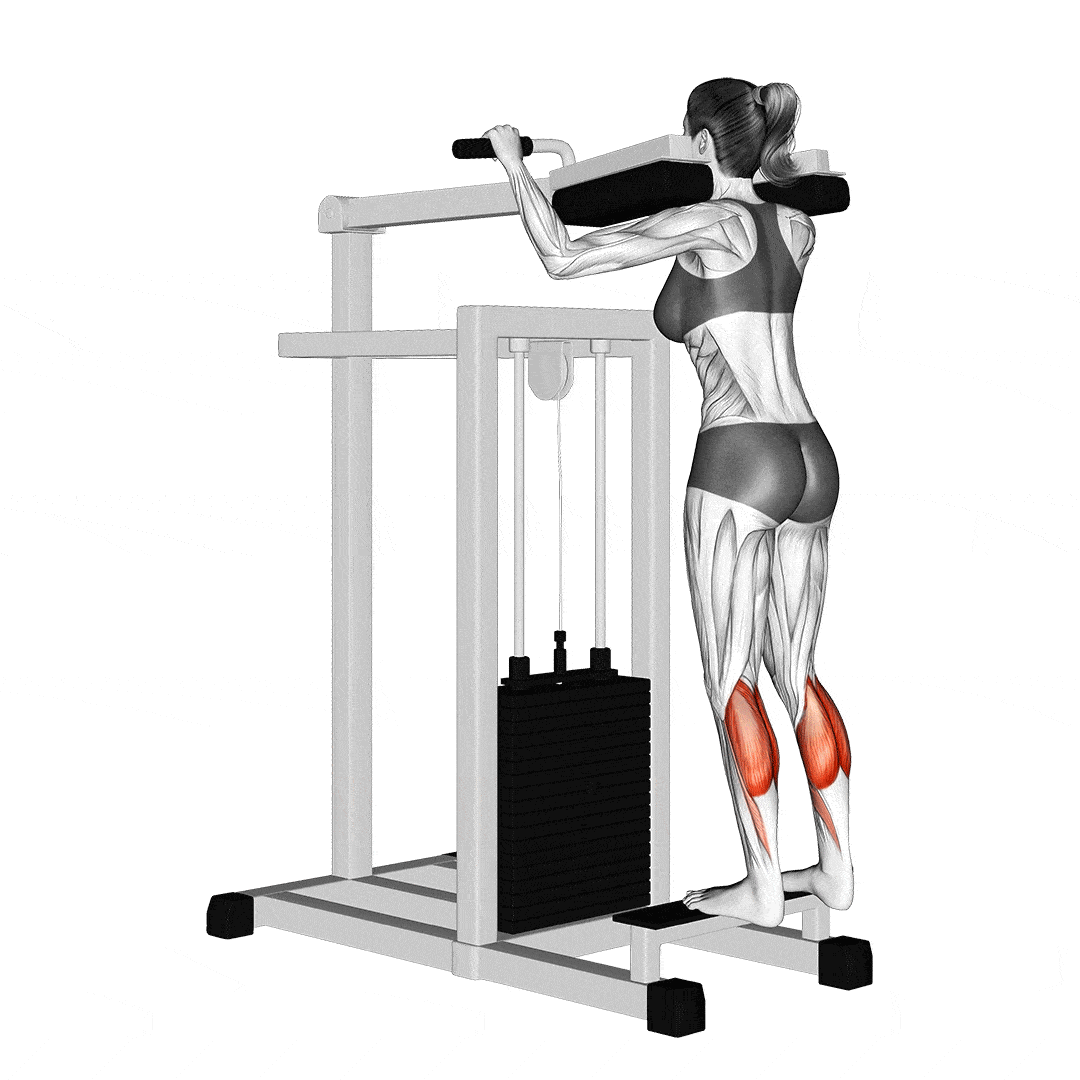
The name of this exercise tells you everything you need to know about it – it’s a calf exercise you perform while standing! When it comes to calf training, the standing calf raise is arguably the most common and popular choice.
Most gyms have a standing calf raise machine, and you can replicate this exercise with your body weight or free weights, too. You may also see people doing standing calf raises with a Smith machine.
Because of this, when most people talk about calf raises, it’s standing calf raises that they’re referring to.
Doing calf raises in the standing position with your knees straight offers several advantages over seated calf raises. Still, the most significant benefit is that this exercise stresses all three calf muscles relatively equally.
We’ve already covered what muscles are trained by standing calf raises. However, for your convenience, they’re covered again in the following section.
Muscles Worked
Standing calf raises involve the same muscles as seated calf raises, namely the soleus, gastrocnemius, and plantaris. However, because your knees are straight during this exercise, the amount of force each muscle can generate is different.
So, while seated calf raises emphasize the soleus muscle and the gastrocnemius and plantaris take a secondary role, during standing calf raises, all three muscles share top billing.
This means that standing calf raises provide a more complete lower leg workout compared to soleus-dominant seated calf raises.
Now that you understand which muscles are working during standing calf raises let’s make sure you know how to do this calf-building exercise.
How to Do Standing Calf Raises
Unlock the full potential of your calf workouts by doing standing calf raises the right way!
- Choose a weight that allows you to perform 10-12 reps with good form. If you’re new to this exercise, start lighter and work your way up.
- Step onto the standing calf raise machine, positioning your shoulders under the pads and the balls of your feet on the footplate. Your heels should be hanging off the edge.
- Grasp the handles on the machine for stability. Keep your back straight and your core engaged. Look straight ahead and not down at your feet.
- Lower your heels towards the ground, stretching your calf muscles as much as comfortably possible. This is your starting position.
- Push through the balls of your feet to raise your heels as high as you can. At the top, pause briefly to squeeze your calf muscles.
- Slowly lower your heels back to the starting position, feeling the stretch in your calf muscles.
- Continue for the desired number of reps.
Pro Tips
- Keep your knees slightly bent but stable throughout the exercise to avoid strain.
- Focus on a full range of motion, lowering your heels as much as possible and raising them as high as you can.
- Make sure your feet are parallel and hip-width apart for balanced muscle engagement.
- Use the handles for balance only; don’t pull yourself up with them.
- To really challenge yourself, try single-leg standing calf raises or add pause reps to your sets.
Now you know how to do standing calf raises, let’s see if they are the right exercise for you!
Standing Calf Raise – Pros
Level Up Your Fitness: Join our 💪 strong community in Fitness Volt Newsletter. Get daily inspiration, expert-backed workouts, nutrition tips, the latest in strength sports, and the support you need to reach your goals. Subscribe for free!
Standing calf raises offer several notable advantages and benefits. So, is it the right exercise for you? Consider these pros and then decide!
A Complete Calf Workout
Where seated calf raises emphasize your soleus muscle, standing calf raises involve all three to a greater degree. That’s not to say the soleus is working any less, just that the gastrocnemius and plantaris are working more. This may be advantageous if you want to make your calf workouts more time-efficient.
In terms of muscle engagement, this is how much work each one is doing during seated vs. standing calf raises (1):
| Muscle | Seated calf raise | Standing calf raise |
| Soleus | 70-80% | 30-40% |
| Gastrocnemius | 20-30% | 70-80% |
| Plantaris | 10-20% | 0-10% |
A More Functional Exercise
Standing, walking, running, and jumping are standing activities. If you want to boost your strength for these activities, the standing calf raise will probably transfer better than seated calf raises.
Lift More Weight
Using all three calf muscles simultaneously means you should be able to lift more weight standing than seated. This may be advantageous if you are training for strength. More weight may transfer to better hypertrophy (muscle gains).
Easy to Do Without a Machine
The standing calf raise machine is popular, common, and easy to use. However, it’s not the only way to do standing calf raises. You can also do this exercise on the edge of a step with a dumbbell in your hand or one-legged in lieu of any external load. Because of this, standing calf raises are more accessible for home exercisers than seated calf raises.
Of course, there are also a few disadvantages to standing calf raises, which are covered in the following section.
Standing Calf Raise – Cons
While standing calf raises are a safe and effective exercise, there are a couple of disadvantages to consider, too:
Spinal Compression and Lower Back Stress
With the load resting on your shoulders, heavy calf raises put a lot of vertical stress on your spine, which can cause compression of the intervertebral disks. In short, this exercise could make you temporarily shorter and could even cause back pain.
The good news is that spinal compression is only temporary, and your disks will return to their usual thickness a few hours after your workout. However, if you have any lower back issues, you may want to proceed cautiously with standing calf raises, as they may exacerbate it.
Pressure on Your Shoulders
Even padded standing calf raise machines put a lot of pressure on your shoulders. This can be especially problematic for people with narrow shoulders, who are lightly muscled, or for women. Needless to say, this pressure increases as you get stronger and the weights get heavier.
Seated vs. Standing Calf Raise – Summary
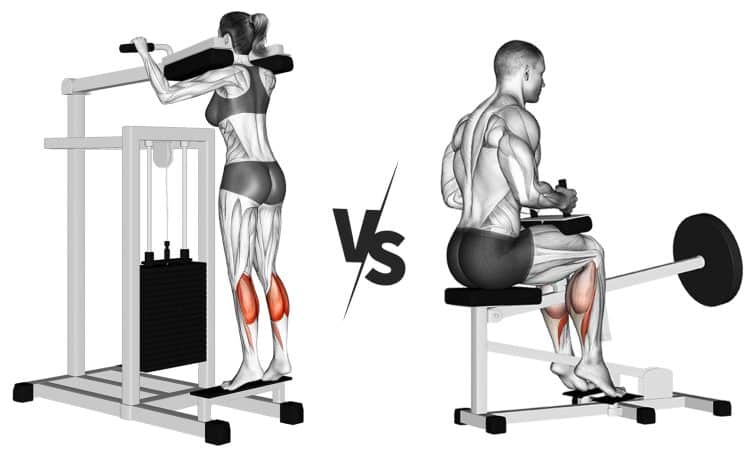
We’ve covered a lot of information in this article – it’s thorough! So, to save you from reading through even more text, here are the critical differences between seated and standing calf raises, presented in a simple, easy-to-read table. You’re welcome!
| Criteria | Seated Calf Raises | Standing Calf Raises |
| Muscle Activation | Emphasizes the soleus while also working the gastrocnemius and plantaris to a lesser degree. | Similar soleus engagement, but gastrocnemius and plantaris are more active. |
| Range of Motion | Smaller range of motion. | Larger range of motion |
| Ease for Beginners | Easier to master; less likely to result in form errors. | May require more attention to form, especially for beginners. |
| Back Stress | No back stress to speak of. | A lot of spinal compression, depending on the load used. |
| Core Engagement | Minimal. | Significantly higher. |
| Loading Potential | Low load potential because the soleus is doing more of the work alone. | Higher loading potential as all three calf muscles are fully engaged. |
Seated vs. Standing Calf Raise – FAQs
Do you have a question about seated vs. calf raises or calf training in general? No sweat because we’ve got the answers!
1. Which is better – seated or standing calf raises?
While both exercises have value, in terms of bang for your buck, standing calf raises are probably better than seated calf raises. That’s because seated calf raises emphasize the soleus, which is a relatively small muscle. In contrast, standing calf raises also work the gastrocnemius, which is the larger of the calf muscles and responsible for most of your lower leg size.
That said, if you want to increase lower calf size without adding mass to your upper calves, seated calf raises are the best way to do it.
2. Why won’t my calves grow?
There are a few reasons why some people find it hard to develop bigger calves. These include:
Genetics: Some people are simply born with larger calves than others. This is due to the genetic makeup of their muscle fibers. People with a higher percentage of fast twitch fibers in their calves will find it easier to develop bigger calves than people with a higher percentage of slow twitch fibers.
Bodyweight: People with a higher body weight may find it easier to develop bigger calves than people with a low body weight. This is because the calves must work harder to support a higher body weight, e.g., while standing, walking, or running. This helps explain why overweight people often have large calves despite not exercising.
Activity Level: People who are active and regularly use their calves will find it easier to develop bigger calves than sedentary people. This is because the calves are constantly being worked and stimulated.
Training Methods: Some training methods are more effective for developing bigger calves than others. For example, exercises involving a full range of motion and high resistance are more effective than those involving a limited range of motion and low resistance.
Lack of Consistency: It takes time and consistency to develop bigger calves. People who give up easily will not see results. You need to work your calves hard several times a week for many months to gain appreciable muscle size.
3. Do you have any good calf workouts?
We certainly do! Here are just a few of the calf workouts we’ve got in Fitness Volt.
- Best Old-School Calf Workouts & Exercises
- Calf Workouts with Dumbbells For Monstrous Lower Legs
- Why Your Calves Are Skinny and How to Fix Them
- How Schwarzenegger Turned His Weak Calves into A Showcase Muscle
- You can find more in our calf training archives!
4. How many reps should I do for calf raises?
Your rep range should match your training goals. Generally, that means 1-5 reps with heavy weights to build strength and 6-30 reps with moderate loads to increase muscle size and muscular endurance.
However, because the calves are made up of a couple of different muscles, and each tends to contain different types of muscle fibers, some people believe the gastrocnemius responds best to lower reps, e.g., 6-12 while the soleus does better with higher reps, e.g., 15-30.
| Muscle | Fast twitch fibers (%) | Slow twitch fibers (%) |
| Gastrocnemius | 50-70 | 30-50 |
| Soleus | 80-90 | 10-20 |
However, this is purely anecdotal and based on average fiber makeup, which may vary from person to person. That said, if your calves aren’t responding how you want them to, it may be worth trying this strategy.
Regarding sets, it’s generally best to try and rack up 10-20 sets per muscle group per week. This is usually easiest if you spread those sets over several workouts. For most people, this means 2-3 calf workouts per week, each comprising 5-10 sets for your calves. For example, three sets of standing calf raises, and three sets of seated calf raises twice a week.
5. How do I make my calves smaller?
While many exercisers dream of building bigger calves, some want to make their lower legs slimmer. This is especially true for women, who often don’t want big calves, as it can make their legs look less feminine and make it harder to wear knee-high boots.
The only real way to make a muscle smaller is to avoid using it. This will cause atrophy, i.e., muscle breakdown and wastage. Ways to do this include avoiding weight-bearing exercises and activities like running, walking, and cycling and not training your calves directly.
You should also avoid wearing high-heeled shoes, which encourage calf growth, and losing body fat may help make your calves smaller if you are overweight.
6. What are some alternative calf exercises?
Seated and standing calf raise machines are just two of the many ways you can train your calves. Other options include:
- Ankle jumps
- Box jumps
- Donkey calf raise
- Dumbbell shrug to calf raise
- Explosive calf raise
- Farmer’s walk on toes
- Hack squat machine calf raise
- Hill sprints
- Jump rope
- Leg press calf raise
- Single-leg calf raise
- Stair climbs
- Tiptoe farmer’s walk
- Two up, one down calf raise
Any of these exercises can help you build stronger, more muscular calves.
7. How big should my calves be?
According to the classic Grecian standards of aesthetics, your calves should be roughly the same size as your biceps. So, if your arms measure 15 inches, so too should your lower legs. Your ideal Grecian proportions are determined by your wrist size and can be estimated using this easy-to-use calculator. Use this information to identify your perfect calf measurement.
Do you have any more questions? Feel free to ask them via the comments section below!
Wrapping Up
There are a lot of myths surrounding calf training. Some people think that calf size is genetic and that no amount of training will make them grow. In contrast, others believe that, with the right exercises, you can bend your calves to your will and shape them any way you want.
The truth is somewhere between these two views.
The calves are very trainable, and even the skinniest calves will grow if you choose the right exercises and use them regularly. However, the ultimate size of your calves is determined by factors such as muscle fiber dominance, tendon length, and other unmodifiable genetic characteristics.
In short, you might be a calf easy gainer or hard gainer, but it’s unlikely you’re a non-gainer!
In terms of bang for your buck, the standing calf raise is arguably the best lower leg exercise. Having straight knees means your gastrocnemius and soleus muscles are fully engaged, providing the best possible workout.
In contrast, seated calf raises take work away from the gastrocnemius and emphasize the smaller, slenderer soleus. This basically means you’re directing more energy to a less crucial muscle.
So, by all means, include seated and standing calf raises in your workout, but understand that standing calf raises are the most productive of these two exercises, so they deserve more of your time and energy. Use seated calf raises to supplement your standing calf raise training.
Above all, remember your calves won’t grow if you don’t train them hard and often. So, pick a calf training program, work it like it’s your job, and let’s turn those little calves into beefy cows!
- The Squat Vs The Leg Press
- Traditional Vs Sumo Deadlift
- The Pull Up Vs The Pulldown
- The Bench Press Vs The Dumbbell Fly
- The Standing Vs Seated Overhead Press
- Crunches Vs Planks: The Best Exercise For Ripped Abs
- The Deadlift Vs The Pull Up Vs The Barbell Row
- EZ Curl Bar And Preacher Curls Vs Barbell And Dumbbell Curls
- Compound Vs Isolation Movements
- Free Weights Vs Machines
- Dips Vs Bench Press: The Best Chest Building Exercise
- The Romanian Vs Stiff Leg Deadlift
- Whey Vs Casein
- Dips Vs Close Grip Bench Press Vs Skullcrushers
- Bench Press Vs Pull-Ups Vs Shoulder Press – The Best Upper Body Lift
References:
1. Zellers JA, Brorsson A, Silbernagel KG. Impact of seated and standing positions on triceps surae muscle activation in unilateral Achilles tendon rupture. Transl Sports Med. 2020 Jan;3(1):3-8. doi: 10.1002/tsm2.117. Epub 2019 Oct 20. PMID: 32432214; PMCID: PMC7236791.
2. Hébert-Losier K, Schneiders AG, García JA, Sullivan SJ, Simoneau GG. Influence of knee flexion angle and age on triceps surae muscle activity during heel raises. J Strength Cond Res. 2012 Nov;26(11):3124-33. doi: 10.1519/JSC.0b013e31824435cf. PMID: 22190157.
3. Arnsdorff K, Limbaugh K, Riemann BL. Analysis of Heel Raise Exercise with Three Foot Positions. Int J Exerc Sci. 2011 Jan 15;4(1):13-21. PMID: 27182353; PMCID: PMC4738962.

